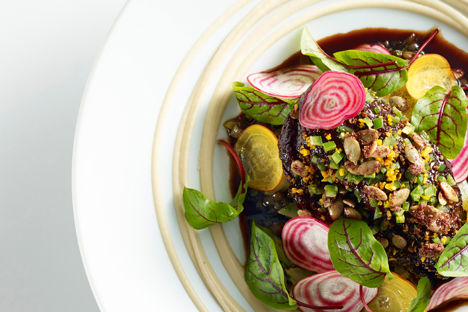
Culture club: the story of Canadian cuisine
From Montréal-style bagels to Icelandic vinaterta, the food of Canada takes influences from across the globe and brings them together to create something truly delicious. Discover the incredible effect international communities have had on the country's cuisine.
Culture club: the story of Canadian cuisine
From Montréal-style bagels to Icelandic vinaterta, the food of Canada takes influences from across the globe and brings them together to create something truly delicious. Discover the incredible effect international communities have had on the country's cuisine.
You can’t get much more multicultural than Canada. International communities have been establishing themselves and growing in all four corners of the country for centuries and, from the 1970s onwards, multiculturalism has been actively encouraged by the government. It’s this welcoming, diverse approach found in Canadian society that has made the country what it is today, having a huge effect on any nation’s most important cultural identity – food.
Without Montréal’s Jewish community, Québec’s famous French heritage and the north and eastern European immigrants that made the Prairies their home, some of Canada’s most famous dishes would never have existed. Here, we take a look at the ways some of the country’s largest international communities have made their mark on Canadian food and drink, creating a melting pot of flavours, ingredients and cooking techniques.
French Québec
Without a doubt the most well known community in Canada is found in Québec, where French is the first language – English is almost non-existent in schools, the media and on signs. Home to cultural hubs such as Québec City and Montréal, it’s a haven for artists and has managed to retain its unique traditions and customs over the years.
As you’d expect from any community evolved from French colonists, the food of Québec is of huge culinary significance. While the most internationally famous food is poutine – a pile of French fries topped with gravy and cheese curds – it is the tourtières (slow-cooked meat pies), pâté chinois (a dish derived from hachis Parmentier similar to shepherd’s pie) and cretons (a spreadable pâté made from pork, adapted from French rillettes) that really epitomise the French influence on Québec’s cuisine.
Jewish Montréal
Within Québec province, Montréal has a culture of its own. While the French dishes mentioned above are found in abundance (the city is home to the most restaurants per citizen in the whole country), the mass immigration of Jewish people in the late 1800s, many of which settled in Montréal, introduced new dishes to the native cuisine.
Jewish delis are some of the most popular places to grab a bite to eat in all of Montréal, catering for all appetites at all times of day. Schwartz’s, arguably the most famous deli in the entire city, stays open until the early hours with a queue snaking out of the door right up to closing time. Most famous for Montréal-style smoked meat (Canada’s version of pastrami) sandwiched between fresh bread with juicy pickles and mustard, it’s a must-visit for any intrepid foodie. Smoked meat is also served up in Montréal-style bagels all over the city, which are sweeter and slightly more compact than the traditional variety. Snowdon Deli is another hotspot for people after an authentic taste of Jewish-Canadian cuisine, with a matzo ball soup that’s constantly named as the best in the city.
For dessert, the city’s Jewish bakeries have everything you’d need to satisfy a sweet tooth. Chocolate babkas, a sweet dough twisted with gooey chocolate and baked like a loaf of bread before being cut into slices to expose its marbled appearance, are one of the most popular. For something a little less filling, rugelach are croissant-like pastries made from a cream cheese dough flavoured with all sorts of nuts, fruits and spices.
Icelandic Winnipeg
The region of Manitoba in the Canadian Prairies became home to immigrants from all over eastern and northern Europe in the 1800s, but it’s the Icelandic community that perhaps had the most surprising effect on the area’s cuisine. A large group settled next to Lake Winnipeg in 1875 and named the area New Iceland, building schools and churches the minute they arrived. Today, Manitoba is home to the largest Icelandic community outside of Iceland, and some of the local delicacies on offer stem right back to the old country.
Vinarterta is a classic example of how Canada’s society has absorbed international influences. The layer cake, filled with prune jam and flavoured with cardamom, is now a common Christmas treat in Manitoba, made popular by the Icelandic settlers way back in the 1800s, who brought the recipe with them from overseas. However, if you’re after a slice in Iceland itself you might be searching for a while – it is now all but unheard of on the Nordic island.
Other Icelandic delicacies are eaten with aplomb in Manitoba (and, nowadays, the rest of Canada). Kleinur (also known as Icelandic doughnuts), laufabrauõ (flatbreads decorated with patterns and eaten around Christmas), kransakaka (an Icelandic wedding cake originally from Scandinavia flavoured with almonds) and rugbraud (Icelandic rye bread)can be found in the Icelandic bakeries of Winnipeg, where there is still a strong patriotism associated with Icelandic ancestry and customs.
As you can see, a lot of Canadian food didn’t originate in Canada. But by actively encouraging a multicultural society and nurturing the international communities which came to seek a new life throughout the 1800s, the Canadian people have been rewarded with one of the most diverse cuisines in the world. The smoked meats, tourtières and vinarterta found in different areas of the country sit side by side with native ingredients such as maple syrup, while contemporary chefs drive forward local food scenes, constantly discovering new combinations of ingredients. It’s an exciting time to be a foodie in Canada – a country that’s quickly becoming a world renowned culinary destination.


